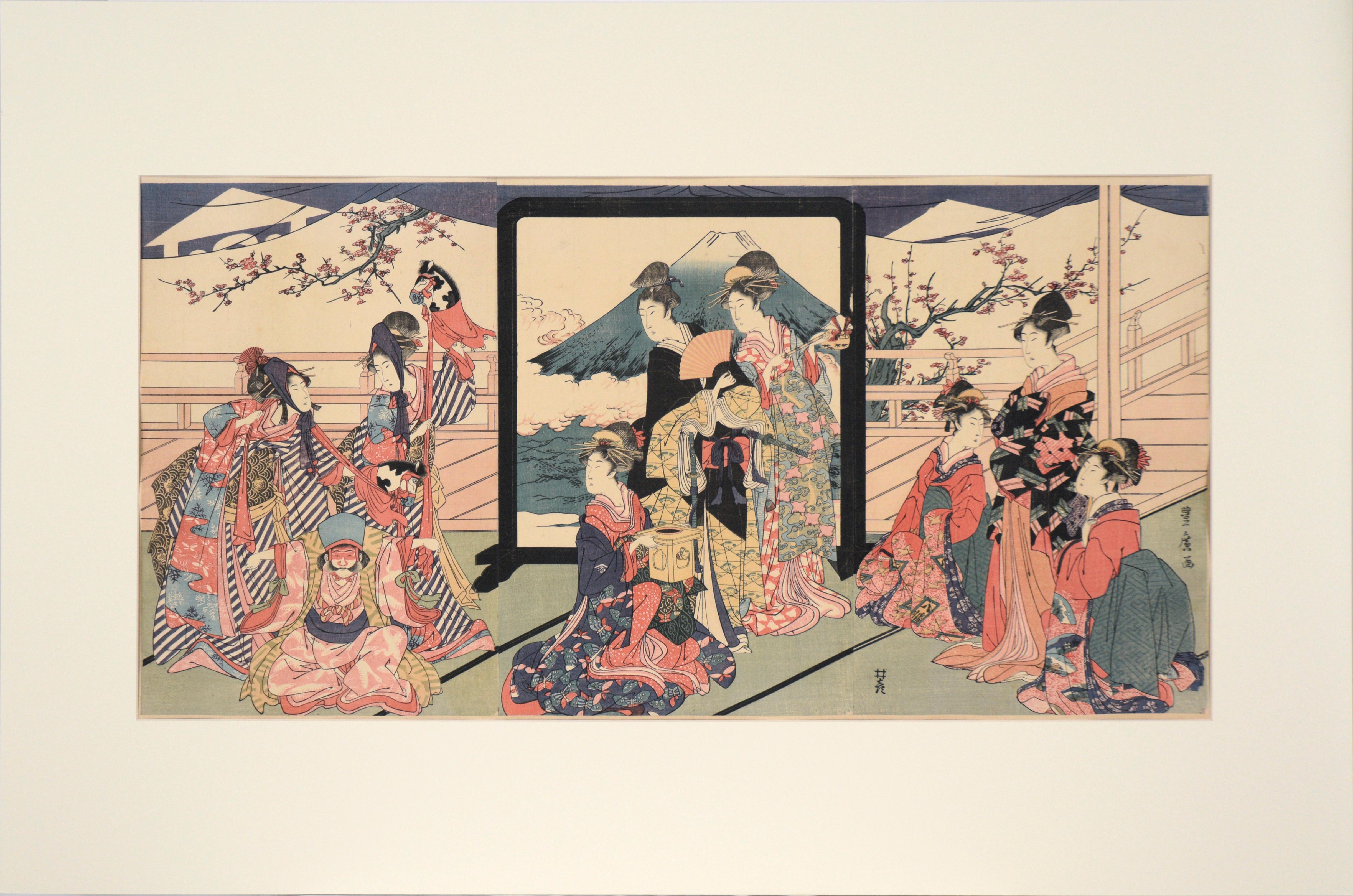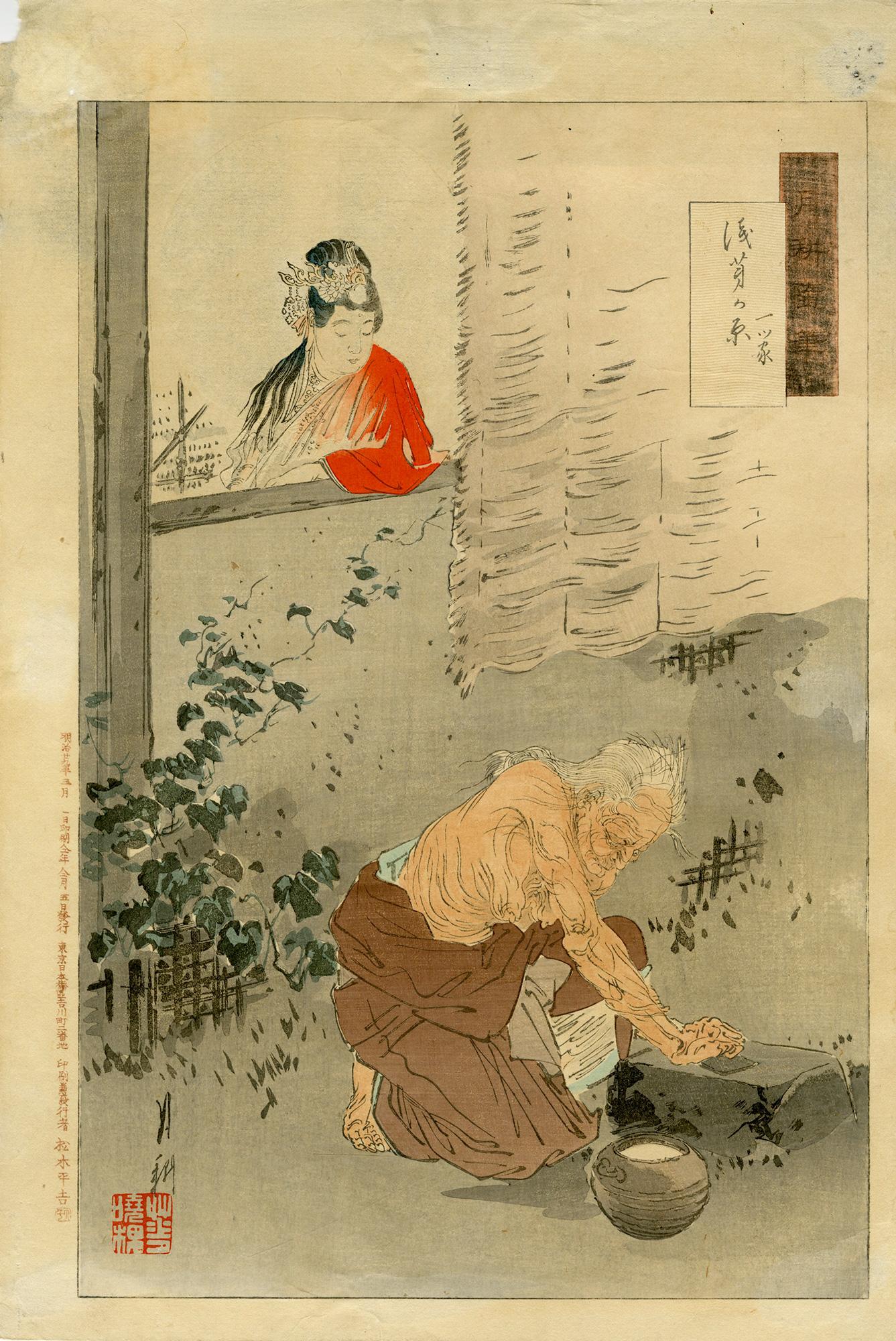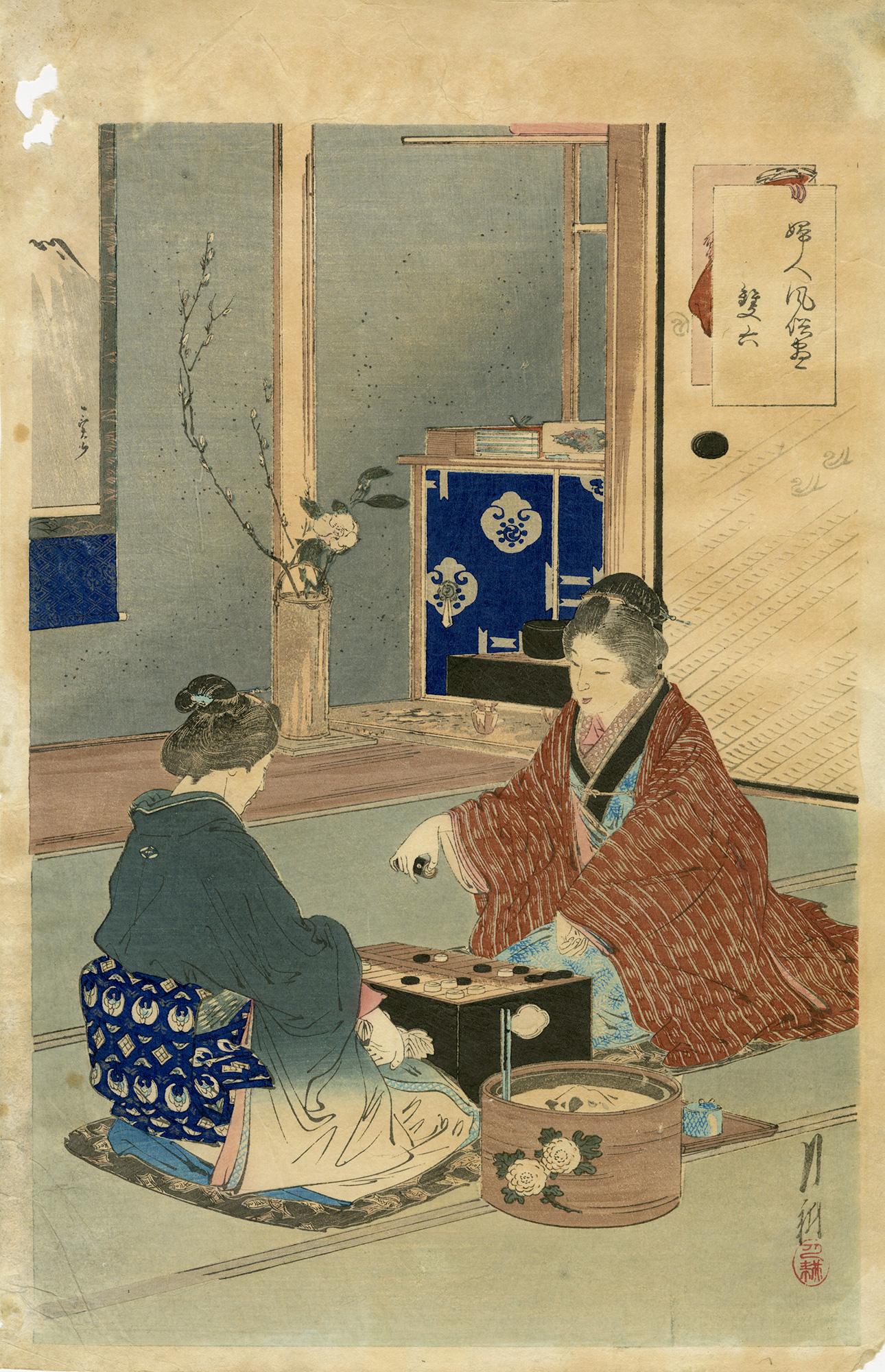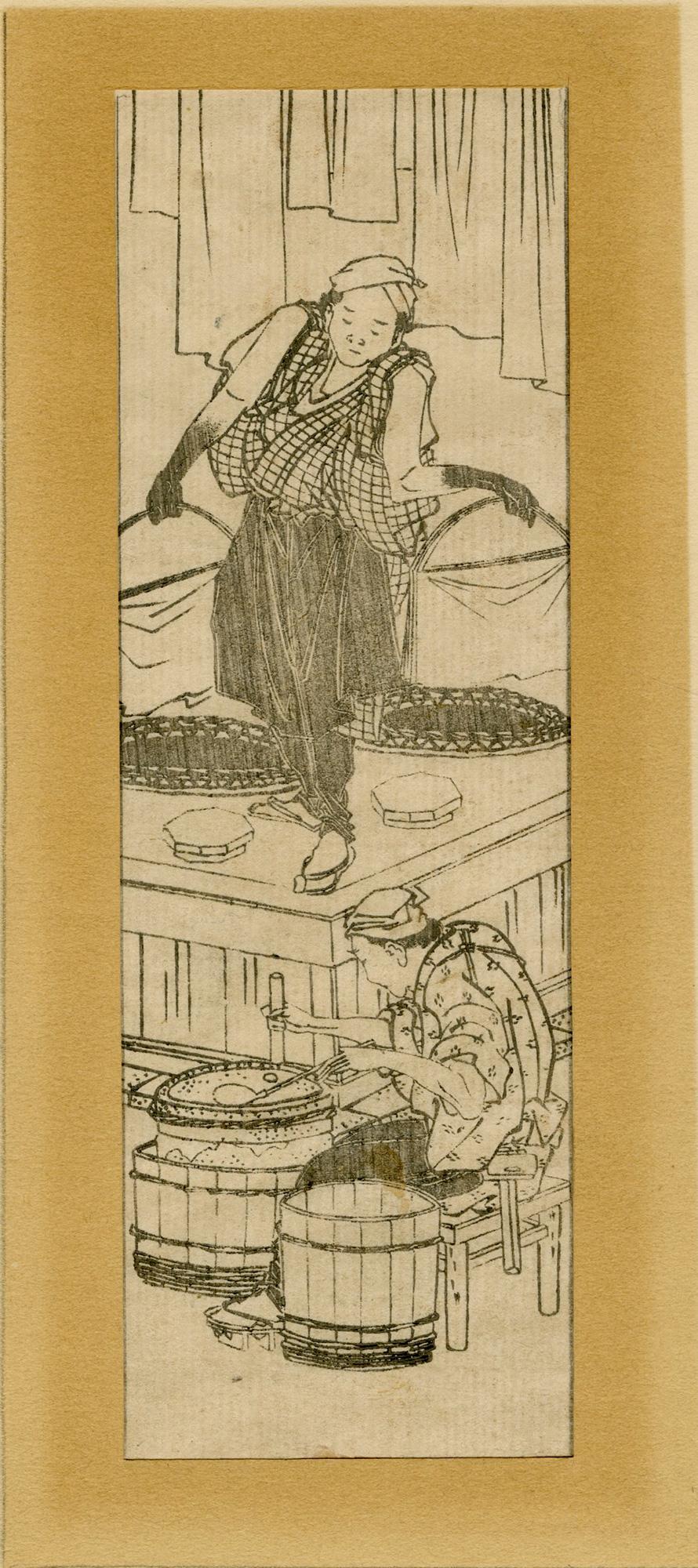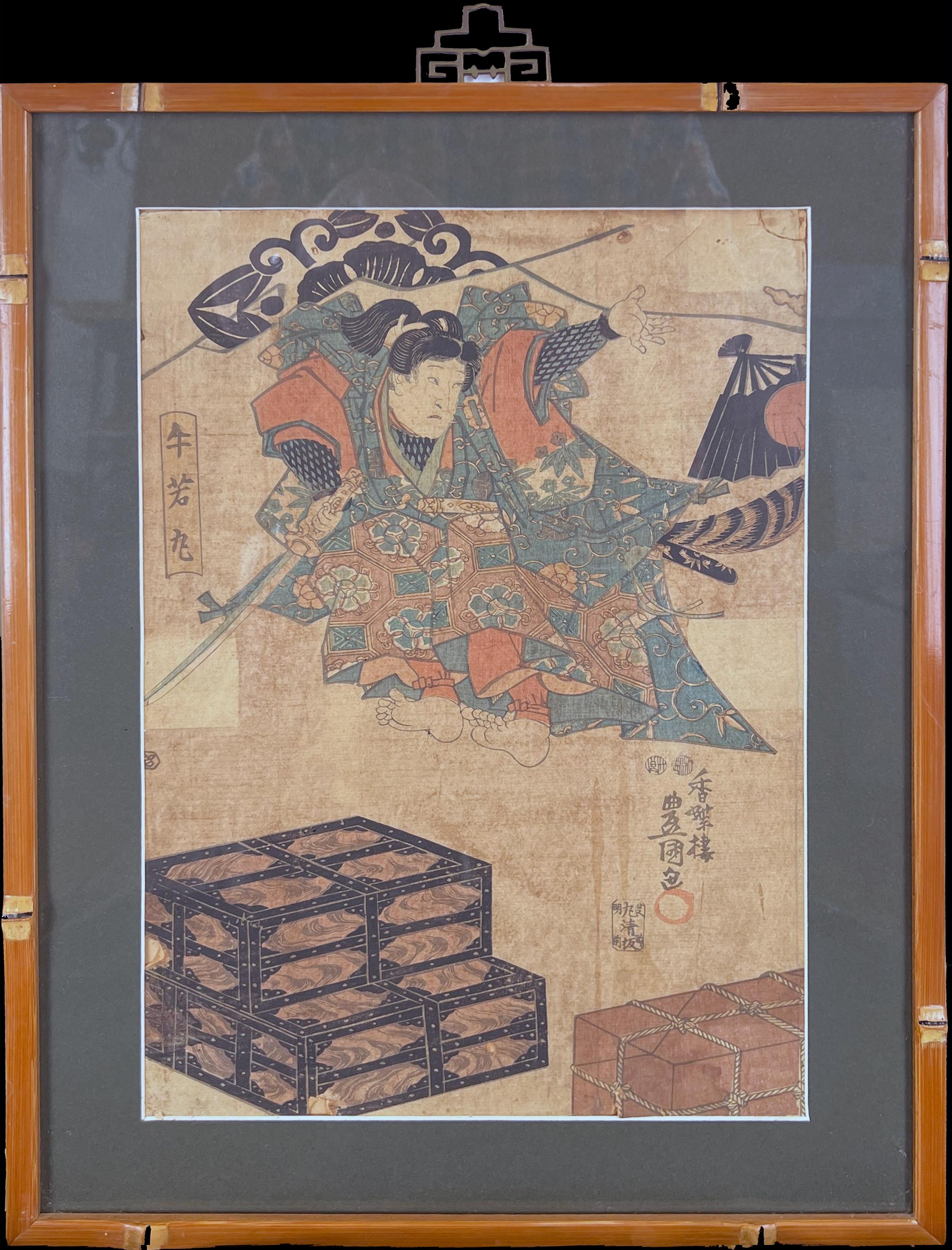Items Similar to Deutzia Flowers: The Wife of Kasamori - Original Woodblock Print
Want more images or videos?
Request additional images or videos from the seller
1 of 10
Suzuki HarunobuDeutzia Flowers: The Wife of Kasamori - Original Woodblock Print1769
1769
About the Item
Deutzia Flowers: The Wife of Kasamori - Original Woodblock Print
Deutzia Flowers: The Wife of Kasamori, from the Series "Beauties of the Floating World Associated with Flowers" by Suzuki Harunobu
(c. 1768–1769).
Suzuki Harunobu is a ukiyo-e artist who was active at the beginning of the nishiki-e period. The beautiful women of the streets of Edo were taken as the theme of his nishiki-e art, and the works of Harunobu that stimulated interest in this genre gained popularity. “Deutzia Flowers: The Young Woman of Kasamori” is a series that likened the existing beauty of young women to flowers. It features “Unohana,” features Osen, the poster girl the “Kagiya” teahouse in Kasamori Inari Shrine in Yanaka. Standing in front of a Shutorii (a traditional Shinto shrine gate colored red) representing the Kasamori Inari Shrine, at a teahouse with a furnace and chagama (tea kettle) that serves tea, is Osen, a slender beauty wearing a Kosode robe with a crest of ivy and holding a tray. On a garden bench sits a billet doux received by Osen. Sharing popularity with Osen is Ofuji of the Yōjiya “Motoyanagiya” in Sensōji Temple in Asakusa. In this series, the nishiki-e artwork “Violet” (collection of museum), depicting two beautiful Meiwa era women.
Presented in a giltwood frame.
Frame: 18"H x 14"W
Image: 10.75"H x 8"W
Suzuki Harunobu thus became one of the primary producers of images of bijinga (pictures of beautiful women) and kabuki actors of Edo, and of similar and related subjects for the Edo print connoisseur market. In a few special cases, notably his famous set of eight prints entitled Zashiki hakkei (Eight Parlor Views), the patron's name appears on the print along with, or in place of, Harunobu's own. The presence of a patron's name or seal, and especially the omission of that of the artist, was another novel development in ukiyo-e of this time.
Between 1765 and 1770, Harunobu created over twenty illustrated books and over one thousand color prints, along with a number of paintings. He came to be regarded as the master of ukiyo-e during these last years of his life, and was widely imitated until, a number of years after his death, his style was eclipsed by that of new artists, including Katsukawa Shunshō and Torii Kiyonaga.
In addition to the revolutionary innovations that came with the introduction of nishiki-e, Harunobu's personal style was unique in a number of other respects. His figures are all very thin and light; some critics say that all his figures look like children. However, it is these same young girls who epitomize Harunobu's personal style. Richard Lane describes this as "Harunobu's special province, one in which he surpassed all other Japanese artists - eternal girlhood in unusual and poetic settings". Though his compositions, like most ukiyo-e prints, may be said to be fairly simple overall, it is the overall composition that concerned Harunobu. Unlike many of his predecessors, he did not seek to have the girls' kimono dominate the viewer's attention.
- Creator:Suzuki Harunobu
- Creation Year:1769
- Dimensions:Height: 18 in (45.72 cm)Width: 14 in (35.56 cm)Depth: 0.5 in (1.27 cm)
- Medium:
- Movement & Style:
- Period:1760-1769
- Condition:Some age toning to paper.
- Gallery Location:Soquel, CA
- Reference Number:
About the Seller
4.9
Platinum Seller
These expertly vetted sellers are 1stDibs' most experienced sellers and are rated highest by our customers.
Established in 1986
1stDibs seller since 2014
2,542 sales on 1stDibs
Typical response time: <1 hour
- ShippingRetrieving quote...Ships From: Soquel, CA
- Return PolicyA return for this item may be initiated within 14 days of delivery.
More From This SellerView All
- "Toy Horse Dance" Japanese Woodblock Triptych with Beauties and Mt FujiLocated in Soquel, CA"Toy Horse Dance" Japanese Woodblock Triptych with Beauties and Mt Fuji Vibrant three-panel woodblock print by Utagawa Toyohiro (Japanese,...Category
Early 20th Century Edo Figurative Prints
MaterialsWoodcut, Rice Paper, Ink
- Ichimura Uzaemon XIII - actor as Okaji of Gion, 1862 "The Six Poetry Immortals"By Utagawa Kunisada (Toyokuni III)Located in Soquel, CAIchimura Uzaemon XIII - actor as Okaji of Gion, 1862 "The Six Poetry Immortals" A Japanese Ukiyo-e woodcut print created circa 1862 by artist Utagawa Kunisada (Japanese, 1786-1864). ...Category
1850s Realist Figurative Prints
MaterialsPrinter's Ink, Rice Paper, Woodcut
- Kumasaka Chōhan to Ushiwakamaru - One of a Diptych Original Woodcut PrintBy Utagawa Kunisada (Toyokuni III)Located in Soquel, CAKumasaka Chōhan to Ushiwakamaru is a Japanese Ukiyo-e print created between 1848 and 1854 by artist Utagawa Kunisada (Japanese, 1786-1864). The print is a Diptych, and is part of the...Category
1850s Realist Figurative Prints
MaterialsPrinter's Ink, Rice Paper, Woodcut
- Dressing the Boy Samurai - Kuniyoshi Japanese Woodblock Print Original Wood CutBy Utagawa KuniyoshiLocated in Soquel, CADressing the Boy Samurai - Kuniyoshi Japanese Woodblock Print Original Wood Cut A young Samurai boy is finishing dressing with the help of a younger sister while his mother looks on ...Category
1850s Edo Figurative Prints
MaterialsPaper, Ink, Woodcut
- Elegant Amusements of Eastern Genji - Japanese Triptych Woodblock Print on PaperBy Utagawa Kunisada (Toyokuni III)Located in Soquel, CAElegant Amusements of Eastern Genji - Japanese Triptych Woodblock Print on Paper Dynamic woodblock print with several elegantly dressed figures by Utag...Category
1850s Edo Figurative Prints
MaterialsPaper, Ink, Woodcut
- Scribe and Personal Assistant to the Shogun - Japanese Woodblock Print on PaperLocated in Soquel, CAScribe and Personal Assistant to the Shogun - Japanese Woodblock Print on Paper Detailed woodblock print by an unknown artist, In the style of Suzuki Harunobu. There are two women i...Category
19th Century Edo Figurative Prints
MaterialsPaper, Ink, Woodcut
You May Also Like
- The Lonely House at Asajigahara.Located in Middletown, NYA scene from a series of ghost stories and spooky rural legends. Tokyo: Matsuki Heikichi, 1896. Woodcut in ink with embossing and hand-coloring in watercolor on handmade mulberry pa...Category
Late 19th Century Edo Figurative Prints
MaterialsWatercolor, Woodcut, Handmade Paper
- Two Women Playing Sugoroku from "Comparison of the Customs of Beauties."Located in Middletown, NYA scene from a vanishing Japan. Two Women Playing Sugoroku from "Comparison of the Customs of Beauties."; The Customs and Manners of Women Japan: Matsuki Heikichi, 1891. Woodblock ...Category
Late 19th Century Edo Figurative Prints
MaterialsHandmade Paper, Watercolor, Woodcut
- Dyeing PaperLocated in Middletown, NYJapan: circa 1770. Woodcut on cream laid paper, 7 1/4 x 2 1/2 inches (182 x 63 mm), narrow margins. Laid down to non-archival board with scattered soiling and some adhesive staining...Category
Late 18th Century Edo Figurative Prints
MaterialsHandmade Paper, Woodcut, Laid Paper
- Synagogue Duke's Palace Houndsditch by Th. Sunderland after Pugin & RowlandsonBy Thomas RowlandsonLocated in Middletown, NYA faithful architectural rendering of the earliest Ashkenazi synagogue constructed in London; built about 1690, and subsequently destroyed in the Blitz, 1941. London: Rudolph Ackerm...Category
Early 19th Century English School Interior Prints
MaterialsAquatint, Engraving, Handmade Paper
- North View of St. Paul's Cathedral, London English School, 19th centuryLocated in Middletown, NYLondon: Tallis & Co., 1851 Lithograph on cream wove paper, 11 3/4 x 15 3/4 inches (297 x 398 mm), with vaulted margins at the top sheet edge. Significant toning, and some edge wear. ...Category
Mid-19th Century English School Interior Prints
MaterialsLithograph, Handmade Paper
- The Great Fire of London, 1666By James StowLocated in Middletown, NYA rare early 19th century view of the Great Fire of London over Ludgate, enhanced with hand coloring. London: Robert Wilkinson, 1811. Copperplate engraving with hand coloring in wa...Category
Early 19th Century English School Interior Prints
MaterialsEngraving, Watercolor, Handmade Paper
Recently Viewed
View AllMore Ways To Browse
Antique Flower Light
Antique Paper Flowers
Antique Flower Print
Antique Prints Of Flowers
Framed Antique Prints Sets
Set Of Antique Prints Framed
Flower Seal
Floating Flowers
Kimono Print
Temple Flower
Printed Tray
Antique Shrine
Japanese Kimono Print
Japanese Kimono Prints
Crest Prints
Holding A Tray
Flower Bench
Japanese Rice Paper Painting
